Powdery black lava beaches alongside rocky coasts, unique natural formations, and contrasting microclimates: La Gomera is the second smallest of the Canary Islands, but at least as diverse as all of her big sisters. So let me show you what not to miss and how to easily explore La Gomera, the Canaries’ ravishing wild child, on self-guided tours by public bus.

A Piece of Paradise
As we meander between the small stone houses of the village of El Guro, we come across a sign that vaguely points to a waterfall. And so we keep hiking on a sandy path between bushes and cacti in the slowly fading afternoon sun. Every now and then, a lizard crosses our path. Then we are alone again. The views are breathtaking.

Unfortunately, we are slowly becoming accustomed to the beauty that surrounds us wherever we go. We have to be careful not to become oblivious to La Gomera’s natural treasures. However, El Guro seems particularly picturesque to me. But I won’t lie to you: Every place on the island seemed exceptionally picturesque to me.
Lost in Space And Time
As we walk on, the path gets narrower, the vegetation becomes denser. Where there must once have been a creek, the path turns left. At the narrowest point where the trail becomes even a bit steeper, two women are sitting in a crouch. They are tanned and wear dreadlocks. One has colored hers in a fiery red, the other one wears her bleached locks tied together over an undercut.
Never in my life have I seen so many dreadlocks outside of Jamaica as in La Gomera.
The women speak German. Just like all of the dreadlocked hippie expats and most of the tourists.
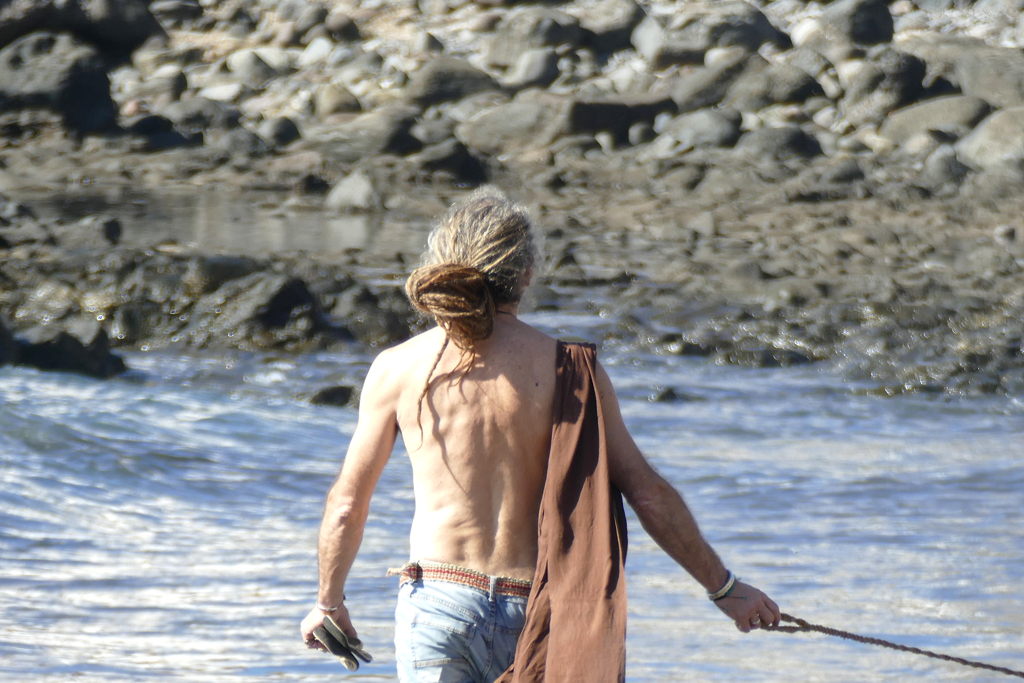
“You have to walk this way for about an hour to get to the waterfall,” explains the red-haired dread lady. She points towards the wild growth. “But be sure to keep an eye on the time!” warns the blonde with the undercut. “In an hour it will be dark and there will be no light. It will be pitch black. You have to be back by then.”
We walk a little further, the path becomes more and more impassable. We have to wade through puddles and climb over slippery stones. You know what, we’ve seen enough beauty for today. Hence, we decide to turn around and leisurely make our way home towards Valle Gran Rey. After all, the journey is supposedly the destination, and on a journey we were.
La Gomera
God was in a playful mood and so he threw a large round stone just willy-nilly into the middle of the Atlantic Ocean. The stone hit less than 50 kilometers off the west coast of Tenerife. There it turned into one of the most beautiful islands Spain has to offer.
At least that’s how I see it. Less imaginative minds claim that Gomera is of volcanic origin and that it rose from the seabed about ten to twelve million years ago as a huge block of oceanic crust.

No matter which version appeals to you more, the fact is that La Gomera is now the second smallest of the Canary Islands. Yet, on just 370 square kilometers, the island combines almost all of the natural beauty that characterizes its bigger sisters.

There are bizarre rock formations covered with cacti, palm trees, and other sturdy vegetation. In the center of the island, you’ll get lured into enchanted fairytale forests. However, Gomera’s black lava beaches are so beautiful that they make it quite difficult to get going.
As I said, like all of the Canary Islands, La Gomera is of volcanic origin. Since volcanic activity on the Canary Islands developed from east to west, La Gomera is older than the western islands of La Palma and El Hierro. Yet, it is much younger than the eastern islands of Lanzarote, Fuerteventura, Gran Canaria, and Tenerife.
The Beginning
North African Berbers settled the island between the 5th and 3rd centuries BC. In 1404, Jean de Béthencourt, who had already conquered Lanzarote and Fuerteventura on behalf of the Spanish crown, failed in his attempt to conquer the small isle due to massive resistance from the locals. Although two of the then-four Gomerian tribes submitted, the other two resisted for decades.

In 1447, the Spanish king entrusted the Peraza family with the government of what was then the county of Gomera. In 1488 the population rebelled against Hernán Peraza’s reign of terror. After he was assassinated, his wife Beatriz de Bobadilla succeeded him. None other than Christopher Columbus is said to have been in love with Beatrice. Because of her, he went ashore in Gomera before his crossings to the New World. But Beatriz was not only beautiful. She was also cruel as she had all members of two native tribes sentenced to death for the murder of her husband. While the men were brutally killed, the women and children were taken as slaves to the mainland and the other Canary Islands.
Tables Turn
From 1837 onwards, the island came under direct control of the Spanish crown instead of a family of counts. Most Gomeros remained poorly paid sharecroppers or even day laborers on the stately plantations. In 1852, the Canary Islands were declared a free trade zone and thus became an internationally sought-after transshipment point.
As on the other islands, cochineal lice provided the sought-after purple dye also in La Gomera. However, with the invention of synthetic dyes, this industry largely collapsed. Consequently, the economic hardship in the Canary Islands inspired a large wave of emigration at the end of the 19th century, particularly to Cuba and Venezuela.
In 1975, after the death of the Spanish dictator Francisco Franco, democratization took place under the Spanish King Juan Carlos. The Canary Islands elected a regional parliament for the first time and received their own regional government. In 1982, the Canaries received their autonomy within Spain.
Today, the residents of La Gomera are politically Spanish. However, many Gomeros feel secluded from mainland Spain in more than just a geographical sense.
Small But Mighty
For the longest time, getting to La Gomera was extremely difficult. This made it a refuge for those tired of the so-called civilization and also an insider tip for those looking for peace and quiet far away from mass tourism. In fact, there has only been a regular ferry connection between Tenerife and San Sebastián de la Gomera since 1974!

In the center of the island grows the world’s largest contiguous laurel forest. It is part of the Garajonay National Park which UNESCO put on its list of World Heritage Sites in 1986. This enchanting woodland as well as almost the entire island can be explored on hikes. However, although La Gomera has an extensive well-designed and clearly marked network of trails, be prepared that we are not talking about comfortable walking paths here. Hiking on La Gomera means sweaty climbs and shaky descents on dirt roads littered with loose rocks.
No Walk in the Park
So don’t even try to set off without the right gear. Sturdy hiking boots, preferably ankle-high, and hiking poles are just the basic equipment. You should definitely have a hat and enough drinking water with you. Don’t forget your sunscreen and take a little snack with you, such as some protein bars. Your phone is fully charged and your GPS is working properly? Then let’s head off to the breathtakingly beautiful mountains of La Gomera!

The mountains that are difficult to pass have given La Gomera an acoustic cultural treasure, the so-called Silbo. It’s a sophisticated whistling language that the Gomeros use to communicate across their vast barrancos, hence gorges. A good Siblo can be heard from miles away. In 1982, UNESCO added El Silbo to the list of World Heritage Sites. Also, the regional government made El Silbo a compulsory subject in Gomera’s primary schools in 1999. I think this is a commendable way to preserve such a unique cultural treasure.
Exploring La Gomera by Public Bus
Do you urgently need rest’n’relaxation? Do you want to relax and do nothing without feeling bad about it? Then La Gomera is the perfect place for you. There’s not much going on. After just a few hours on the island, you notice that your clock is suddenly running slower.
Welcome to Gomera.
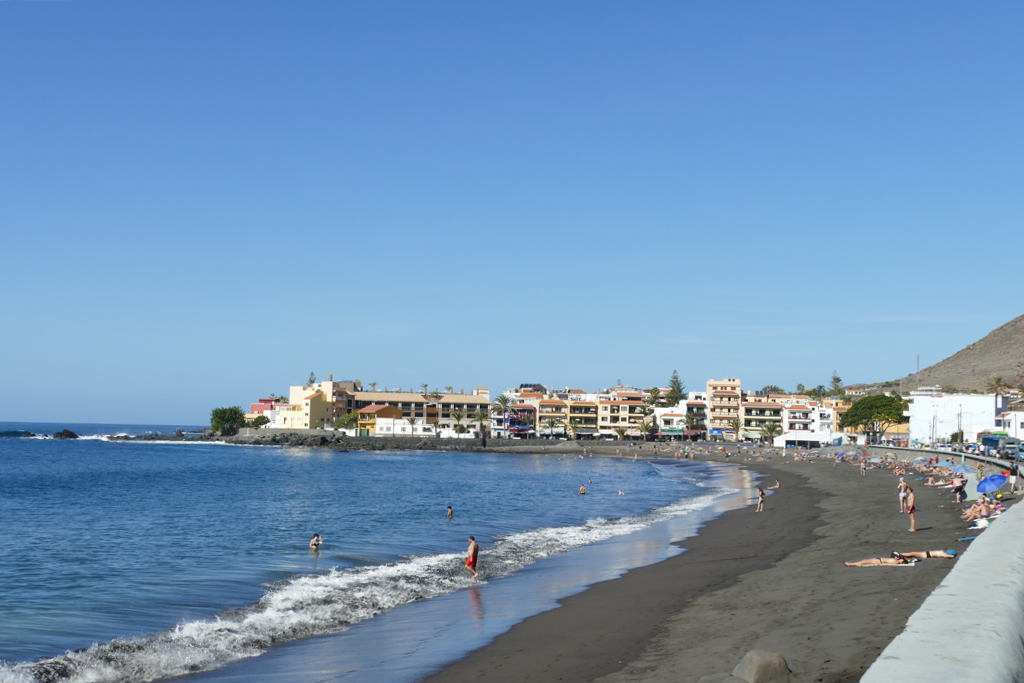
Are you exploding with drive and energy? Do you love lacing up your hiking boots before the first cock crow and becoming one with untouched nature? Or are you living your best life on a surfboard or behind a diving mask in the depths of the ocean?
Welcome to Gomera.
If you aren’t much of an avid hiker, the bus, or La Guagua as it is called in all of the Canary Islands, is the cheapest and, with a bit of planning, the most comfortable way to get around the island. However, since the bus network is much less developed than in Gran Canaria, Tenerife, and Fuerteventura, for example, a little more logistics are required. On the other hand, exploring by bus saves you the nerve-wracking drive on the serpentines and the search for parking spots.
This being said, if you really want to see the entire island exclusively by bus, you shouldn’t take on too much at once. Choose one location per tour and allow for some waiting time.
Don’t Leave Me This Way
The GuaguaGomera bus company has eight lines that connect the main towns as well as the port and the airport. However, mostly, there are only a couple of connections per day, often in the early morning and then again in the late afternoon. Therefore, you need to determine your itinerary for the day and have to stick to it to make it reliably there and back.
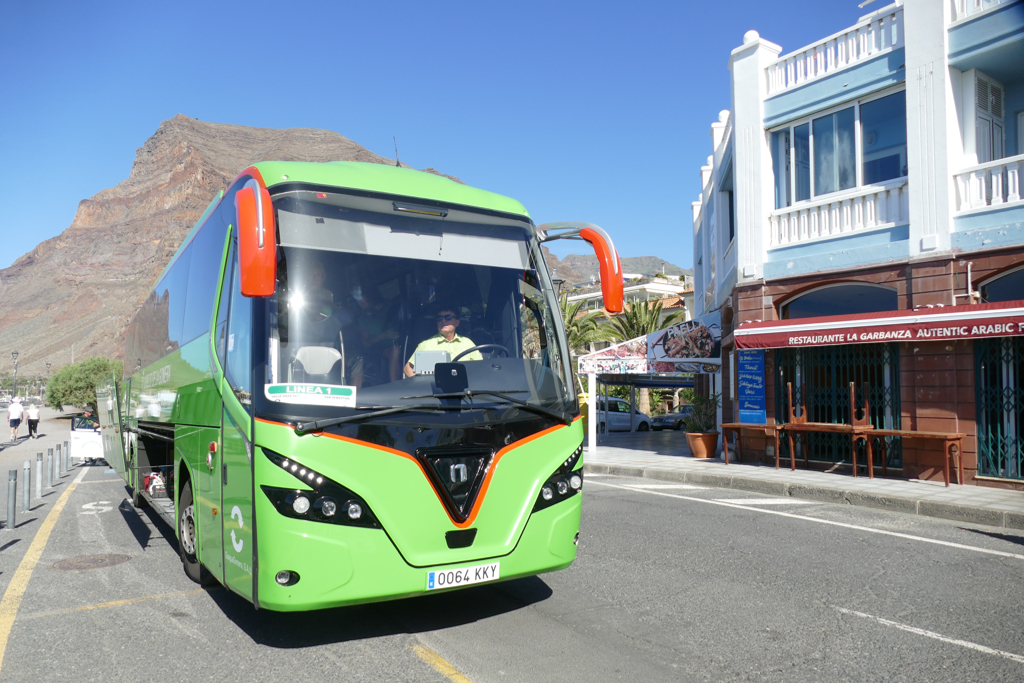
While I can recommend exploring La Gomera by public bus from the bottom of my heart, I need to warn you of one crucial thing: The Guaguas have no handrails, therefore it’s illegal for passengers to stand. And as the drivers don’t want to pay a fine or even lose their jobs over some jolly tourists, they won’t take you with them once all the seats are taken. While in Tenerife, I travelled standing squeezed between large groups of day-tripping tourists, this won’t occur in La Gomera. When the Guagua is full, it’s full and the driver will leave you behind. Your only chance to get back to where you started from will be by cab. And although cabs are less expensive than in many other places, they are still significantly more expensive than the buses, obviously.
The Early Bird Catches the Worm Bus
So what to do? It’s not that difficult: Wherever possible, take the bus at the main bus station. Even if there are various bus stops in the bigger towns like Valle Gran Rey or Vallehermoso, once the Guagua gets there, it might already be full. Also, be at the bus station well ahead of time. I would suggest about twenty minutes before the scheduled departure. And once there, don’t loiter and linger but stand in line at the curb where your bus will be leaving from.
My friend, these are not suggestions, these are golden rules that you should follow especially if you are taking the Guagua to get to the airport or the ferry!
Valle Gran Rey
Valle Gran Rey, which translates to the Valley of the Great King, is a legend as it has been La Gomera’s first expat and tourist destination. Therefore, it has been the best-known and most popular place on the island for many years. Hippies and other dropouts weary of civilization sought cover in the rock caves of this remote place. Eventually, many of those early expats moved to the village of El Guro, and Valle Gran Rey developed into a spot for visitors looking for a relaxing vacation. And this, my friend, was exactly the reason why I chose Valle Gran Rey as my base for exploring La Gomera.

Our visit to the island was meant to be a break from a break in Tenerife and Gran Canaria. Yet, despite our rather short stay of even not an entire week, we wanted to enjoy a bit of everything: Hanging out on the beach, a bit of hiking in the vicinity, exotic vegetation, and local village life.

Although by now, Valle Gran Rey is the most touristically developed place in La Gomera, you won’t find any package tourists or soulless hotel chains here. Most visitors rent self-catering apartments from locals, and so did we. Yes, it was a good exercise to climb the endless stairs or winding slopes up to the neighborhood of La Calera, but once there, we truly enjoyed the breathtaking views – once we caught our breath, that is.

The lower part of Valle Gran Rey offers a glorious sight of terraced horticulture full of lush fruit trees and an abundance of palm trees.
Paradise Found
No wonder the first hippies in the 1970s chose this piece of earthly paradise when they were looking for a place to make their new homes. The valley has sometimes been compared to dropout places like Chefchaouen or Goa.

As I wrote above, I have rarely seen so many dreadlocks in my life. Whether they are in the valley forever or just temporarily, these colorful folks give the village a long-forgotten Woodstock vibe: They sell handmade jewelry, practice acrobatics on the beach, and every evening, they guide the sun to sleep with some moody bongo drumming. All this gives Valle Gran Rey a pleasantly laid-back and relaxing vibe.

Cruises And Boat Trips
Whale Watching
But there are also the beautiful waters of the Atlantic waiting to be enjoyed and explored. While I was super-impressed by the flying fishes I saw during our transfer from the port of San Sebastián to the jetty of Valle Gran Rey, there are bigger fish to catch admire: The waters between La Gomera and neighboring Tenerife have been declared Europe’s first whale sanctuary. With the recognition as a sanctuary, the government wants to prevent uncontrolled whale watching to be able to protect whales and dolphins more sustainably.

From Valle Gran Rey, you can join whale-watching tours organized by qualified professionals. You have the chance to see different types of dolphins as well as whales up close yet in a respectful and gentle manner. Several tour operators leave the harbor every day around 10:30 a.m. to visit the peaceful giants for approximately three hours. A tour costs around 30 euros and usually includes a drink and a small snack.
Los Organos
Another popular sea cruise takes you to Los Organos. These so-called organs are a fantastically shaped rock massif on the north coast. They are considered the most beautiful basalt formations in the Canary Islands. On a stretch of about 200 meters, the cliffs rise like organ pipes 80 meters high from the sea.
These columns on the coast near the town of Vallehermoso are the remains of long-cooled lava masses. Over time, erosion has exposed the rock and further chipped away at the natural work of art. Since the rock massif slopes steeply, the unique Los Organos can only be viewed in their full size by boat tour from the sea. On the journey to the impressive rock face, the ship passes numerous impressive valleys and coastal sections, small towns, and bays. There are also good chances of spotting whales and dolphins along the way.
However, it is important to note that a visit to the Organos depends on the sea currents and is therefore only offered if sea conditions allow. This tour also lasts roughly three hours and costs around 35 euros per person.
Cruise With the Benchi Express
Two to three times a day, the Benchi Express offers ferry connections between San Sebastián to Valle Gran Rey. About halfway, there will be a stop in Playa Santiago. If you are coming to La Gomera by ferry from Los Christianos, this is a far more idyllic way of making it to your final destination than taking a Guagua.
However, the Benchi Express is also perfect for day trips. For a reasonable price, you can enjoy a boat ride for instance to pay Playa Santiago as there is no access to this village on La Gomera’s southern coast by public bus. And although the island’s capital San Sebastián is not exactly a busy hot spot, a stroll through the picturesque alleys lined with traditional Canarian houses should be worth your while. Also, you can always include a couple of hours on one of the adjacent beaches before heading back to Valle Gran Rey.

Benchi Express tickets start at around 15 €uros for a ticket from Valle Gran Rey or San Sebastián to Playa Santiago respectively 18 €uros for the whole route between Valle Gran Rey and San Sebastián. These prices apply to single trips. Note that there is no hop-on hop-off option, you always have to pay for the individual trips.
El Guro
Even if you’re not in La Gomera for the extensive hikes, you should overcome your inner weakness, leave the cozy beach behind for a couple of hours, and head uphill on one of the many hiking trails. The fantastic views of the mountainous landscape, the picturesque villages, and the endless expanse of the sea on the horizon will reward you royally.
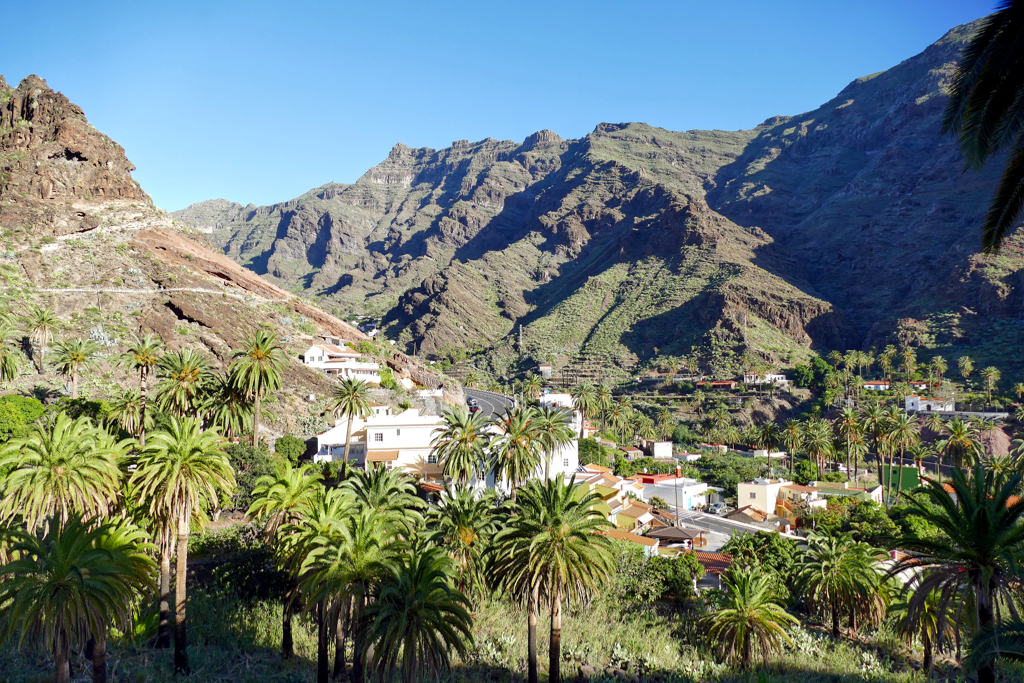
Depending on your fitness, you can already make a first stop on the slopes of the La Calera neighborhood, which is still part of the village.
Getting High
However, I recommend you continue on a gentle slope for another half an hour to El Guro. This village which supposedly has less than a hundred inhabitants is known as the home of artisans and bohemians. Visitors appreciate this enchanting oasis of peace and quiet also for its countless palm and fruit trees, interspersed with clusters of adorable little houses. All this creates a unique vibe and makes El Guro the ideal spot to unwind and relax.
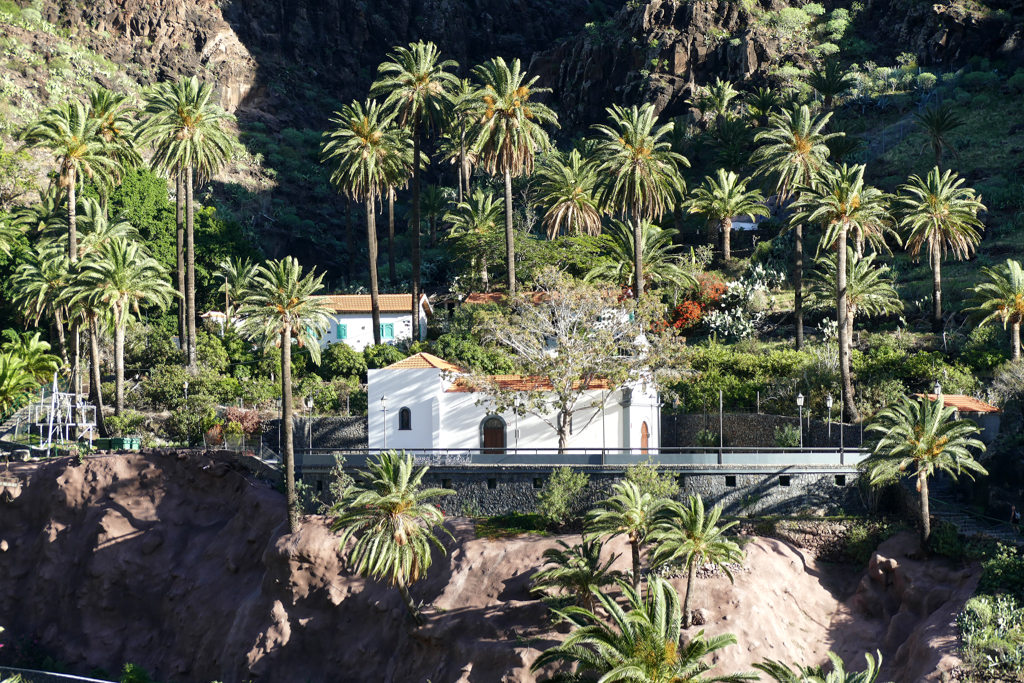
If you book accommodation in El Guro, the price-performance ratio can be a little better than in the lower part of Valle Gran Rey. On the other hand, El Guro is rather recommended as a base if you have a rental car. There is no supermarket and it is a 40-minute walk to the beach. It must also be said that El Guro has no access road and the accommodations are reached through a path of about 130 steps. That’s the price of staying in the middle of untouched nature.
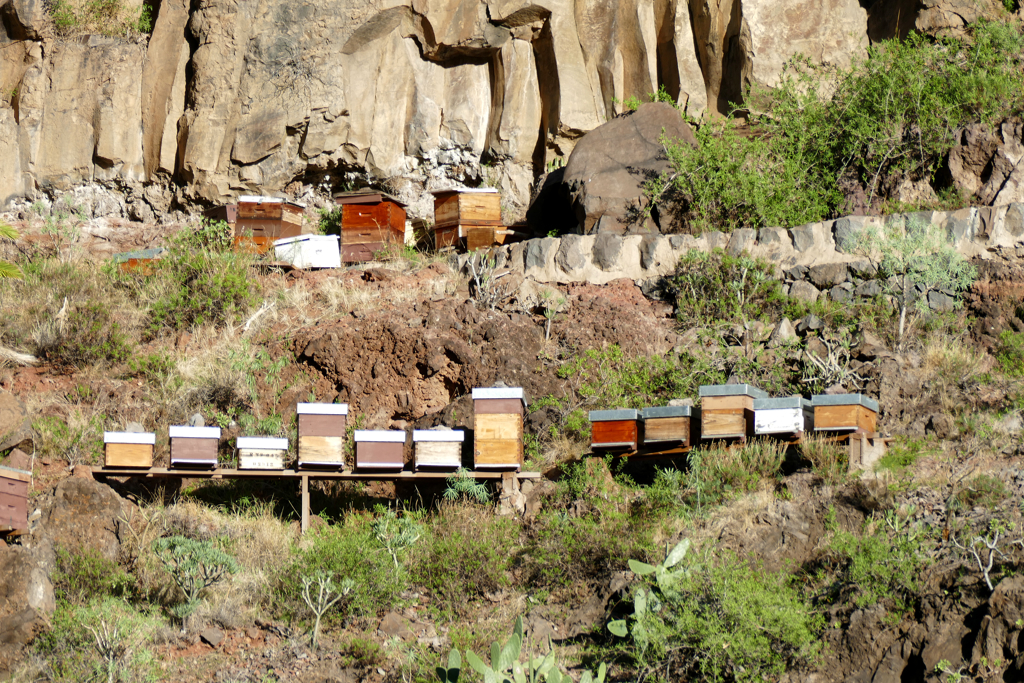
The most popular attraction in El Guro is a small waterfall or more precisely, the beautiful path that leads to it. The hike there takes approximately one and a half hours each way. Although it is a simple path, wearing good footwear is crucial as there are rocky spots, puddles, and slippery stones on the way. Also, keep in mind that once the sun goes down, the patch is not illuminated at all, hence, make sure to make it back in time.
Mirador del Palmarejo
The omnipresence of the late Canarian artist César Manrique extends also to La Gomera, obviously. In 1989, the artist whose work I presented in great detail in my post about Lanzarote, designed the Mirador El Palmarejo viewpoint and the associated panoramic restaurant. The facility is located on the serpentine road above Valle Gran Rey about two kilometers from Arure.
In typical Manrique style, the Mirador was skilfully integrated into the landscape and symbolically connects humans with nature.
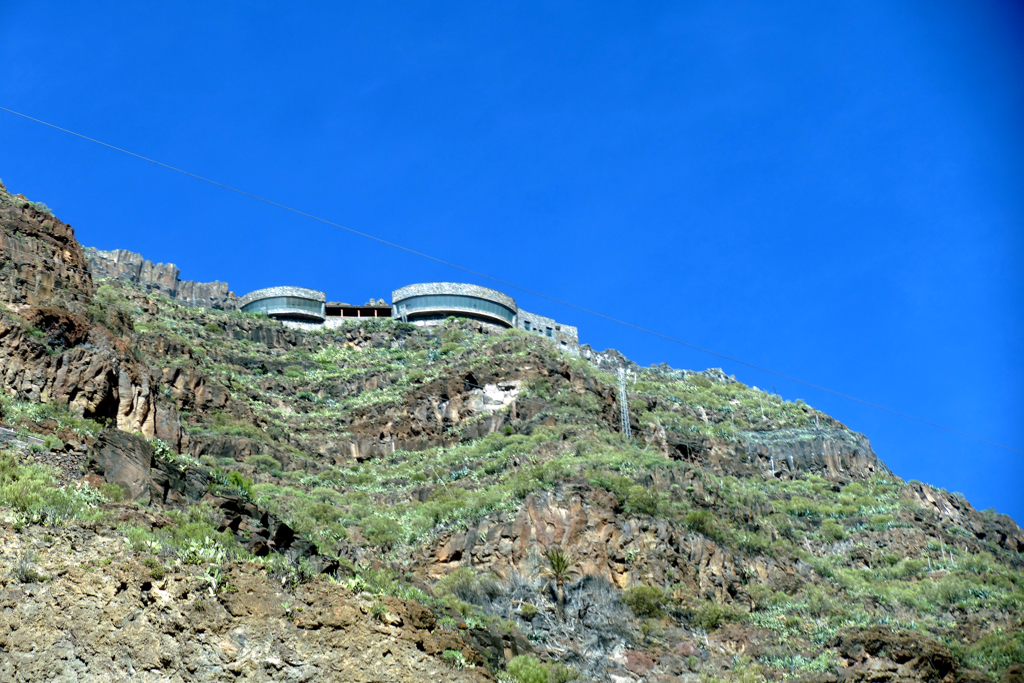
From this vantage point, you have a spectacular view over the valley from the rough rock walls, terraced hillsides, and palm groves all the way to the alluring shores.
The restaurant was run by a vocational school for hotels and catering, but sadly it had to be closed down for economic reasons.
Arure
As you keep going uphill towards the center of the island, next is the mountain village of Arure. At an altitude of 825 meters, it consists of cute traditional houses which are mostly inhabited exclusively by locals. Yet, many visitors get off the Guagua in Arure as it is the starting point for many alluring hikes – mainly downhill, so that makes it really attractive even for the less ambitious wanderers. However, many visitors start their challenging hike up La Merica Mountain right here.
In the wee hours, Arure is often bathed in damp clouds of fog giving the village a mysterious vibe. As soon as the sun comes out, you have a fantastic view of the majestic mountains around, the fertile terraces, the abundance of palm trees, and the glittering Atlantic Ocean far below. Therefore, one of the highlights in Arure’s vicinity is the Mirador del Santo. As a matter of fact, it’s one of the most famous viewpoints in La Gomera.
According to legend, natives Gomerans resisted the Spanish conquerors from their base in Aure. Therefore, its residents take great pride in being direct descendants of the native Canarians.
Garajonay National Park
With a size of almost 4,000 hectares, Garajonay covers ten percent of the island. It became a National Park in 1981 and five years later, UNESCO declared this precious and unique ecosystem a World Heritage Site. It consists of an evergreen cloud forest with ferns up to two meters high. Long beard lichen hanging from moss-covered, gnarled branches make you feel like walking next to Hansel and Gretel through a fairytale forest.

You can easily get to the bus stop in Epina by bus #8 and visit the National Park from there. But keep in mind there are only three daily connections in each direction: At 8 a.m., noon, and 6.30 p.m. from Valle Gran Rey and at 6.30 a.m., 9.30 a.m., and 5 p.m. from Vallehermoso. If you take the early bus to Epina and make it back to the bus stop by noon, you can then add a visit to the beautiful town of Vallehermoso.
It will be a glorious day!
Vallehermoso
Vallehermoso translates to Gorgeous Valley, and let me assure you, they are not exaggerating! As a matter of fact, Vallehermoso is the name of an entire region, but also of a beautiful little town in the northwest of La Gomera. It lies idyllically between rows of imposing mountains and is surrounded by green banana plantations, countless fruit trees, and small vineyards. If you need a foretaste of paradise, make sure to visit this gorgeous valley.

As a matter of fact, in ye olden dayz, Vallehermoso was the economic and cultural hub of La Gomera. Especially around Vallehermoso’s village square Plaza de la Constitution with its fountain and benches and small cafés, you can still feel a rural yet prosperous vibe.

However, today Vallehermoso is mainly the exquisite start and finish of many hikes. Apart from the well-developed road, various hiking trails wind through the lush valley up into the Garajonay Natural Reserve. But even if you only ascend one of the viewpoints above the town center, you will be rewarded with some truly amazing views.
Lost Place
A small curiosity north of Vallehermoso is the Jardin Botanico del Descubrimiento. This botanical garden was founded in the year 2000 under the direction of the botanist Dr. David Bramwell. It covers an area of over 16,000 square meters with plant species from five continents.
However, after the garden was built with a lot of funding, it has been closed for quite a while now. The main gate is locked, and the former reception is slowly decaying. Nevertheless, a side entrance remains open so that this lost place can be entered.

We still preferred to just stay up on the terrace in front of the former visitor center because the area is completely overgrown, and I was afraid that there might be too many insects in the undergrowth. Since this lost place is located next to the road leading to Vallehermoso’s beach, a short pit stop is certainly worth it.
Beach Life
Yes, Vallehermoso’s main attractions are most certainly the valley and the surrounding mountains. Yet, there is also a beach only about three kilometers north of the town. Behind the rocky beach of Vallehermoso, a swimming area with natural pools was created. There, you’ll also find changing rooms, showers, and a snack bar.
The beach of Vallehermoso is surrounded by a ravishing rocky backdrop. Still, you ought to be careful as the Atlantic especially off the northern coast of La Gomera is often much rougher than in the south. Another mutuality all Canaries have in common.

We came to Vallehermoso from Valle Gran Rey by bus #8. However, the town is also connected to the capital city San Sebastián by bus #2. Nevertheless, if you want to go on a day trip that includes several stops, you should check the timetables thoroughly and plan your itinerary accordingly. Otherwise, you might get stranded for the day. Although the bus company’s website GuaguaGomera is very informative, they make things a bit difficult by keeping it exclusively in Spanish. Obviously, you can always open it in a translate extension.
Practical Information
How to Get There
By Plane
Yes, since 1999, La Gomera has an airport. Many people don’t know about it as there are no direct flights to or from international airports. Every day, exactly four flights are coming in and four flights are going out. I wonder how the security people are spending the rest of their day.
Anyway, the regional airline Binter Canarias offers morning and afternoon connections to Gran Canaria as well as Tenerife. However, note that the flights are going to Tenerife’s old airport Los Rodeos in the north.
If you check Binter’s website, don’t get over-excited about the incredibly cheap prices as these apply only to permanent residents. However, even for other passengers, flying between the islands is reasonably priced. Often, it is not much more expensive than the ferry.

The clever people of La Gomera are not wasting time or fuel on pointless bus connections. Therefore, a Guagua is waiting for arriving passengers according to the times of arrival and brings them to either San Sebastián or Valle Gran Rey respectively all the settlements that lie on those routes. From all other places, you either need to take a cab or go by rental car.
As you are going to the airport, the Guagua is leaving Valle Gran Rey respectively San Sebastián around 90 minutes before the scheduled departure. Please, make sure to check the exact hour online or even better, the day before your flight at the bus station!
By Ferry
The most alluring way to reach La Gomera is by ferry from Los Cristianos on the island of Tenerife. There are several ferries per day by Navier Armas as well as Fred Olson. Note that if you are coming from the northern part of Tenerife, there is a shuttle bus that comes free with your ferry ticket. Howsoever, early reservation is highly recommended. The bus departs around one and a half hours before disembarkation from the bus terminal in Santa Cruz. A major additional advantage is that by taking Fred Olson’s shuttle, you cannot miss the ferry as they wait for the bus to arrive.

Nevertheless, if you’re on a flexible schedule, you should check thoroughly the prices at different times of the day as well as between the individual companies. They may differ a lot. Also, just like the airlines, the ferry companies grant residents of the Canary Islands a considerable discount.
The ferry only takes visitors as far as the capital San Sebastián de la Gomera. They then have the option of taking a smaller ferry to Valle Gran Rey. Alternatively, you can get there by bus across the mountains.
Transport of vehicles is possible between Tenerife and San Sebastián. Then, you’ll have to drive as the local Benchi Express ferry only carries bicycles and smaller motorcycles.
Although I’m an avid walker, I recommend taking a cab to your accommodation once you arrive at the jetty of Valle Gran Rey. Especially if you have to schlepp your luggage uphill to the La Calera district. Don’t worry, cabs are much cheaper than in many other places. We paid seven €uros for the ride and given the location, it was money very well spent!
Organized Trips
Even if it’s not always easy and you have to adapt your daily plan to the circumstances or the not-very comprehensive bus schedules, it is definitely possible to explore almost every place on La Gomera by public bus and a short hike. It is doable and certainly not an adventurous challenge. On the other hand, it is of course not the easiest and most flexible way to see the island. There are organized tours that you can book on GetYourGuide*, for example. If you want to set sail to see the large mammals or the Los Organos rock formations, you’ll need a tour operator, anyway.
By the way: A day visit to La Gomera is also a very popular excursion among Tenerife visitors. It is usually offered as a package that includes the ferry round trip from Los Cristianos to San Sebastián and an island tour of La Gomera.
On GetYourGuide*, you’ll find many great activities and tours to join:
Where to Stay
There are various accommodations in all categories in La Gomera. In addition to very few high-priced hotels such as the Hotel Parador* San Sebastian, the Hotel Jardín Tecina* in Playa de Santiago, or the Hotel Gran Rey* in Valle Gran Rey, most visitors find self-catering apartments in holiday complexes. Of course, I’d particularly recommend the option of renting one of the many beautiful private accommodations directly from locals.
We chose one of the four Flor de Lis apartments*, which are rented by a local family and are located up in La Calera. While we took a cab from the jetty to the apartment, the daily climb to this high part of the village was a bit strenuous, yet a good workout. For people with limited mobility, however, this part of the village is certainly too much of a challenge. Some houses are also built on the slopes, so there are many steps to climb. You should definitely check this before booking your accommodation!

I have stayed in many holiday apartments on the Canary Islands and have always found them to be very well equipped. Sometimes you have an electric coffee machine, sometimes an Italian espresso maker. Occasionally you will find a few coffee capsules for the capsule machine or there will be a complimentary bottle of wine. Sometimes there is a washing machine, sometimes a parasol for the beach. They are all different, and I felt comfortable in all of them.
On this map, you will find different accommodations in the different areas of the village and its surroundings. This way, you can choose according to your needs and budget*:
What to Eat
Local cuisine often includes the standard Tapas such as ham, cheese, shrimp in garlic, breaded baby calamari, and the like as a starter.
If the waiter offers you bread and aioli while you’re waiting for your order, it’s a nice gesture. Yet, you’ll later find it on your check. It’s a small amount of two or three €uros, but don’t be surprised.
Fish is normally served with papas arrugadas, potatoes cooked in salted water until they shrivel. They are eaten with their skins and seasoned with Mojo. The green kind of this traditional dip is made with coriander and the red one with chili.

Gofio is a kind of flour where the grain is first roasted and then ground. It is a Canarian staple and definitely worth the try. Also, watercress soup is a specialty in La Gomera.
Fruitilicious
I was amazed at how many different fruit trees are growing in La Gomera. Apart from the classics like bananas and oranges, you can find pomegranates, mangoes, passion fruits, and, above all, papayas in abundance. As a matter of fact, there is hardly a tastier and healthier way to beat the Canarian heat than to quench your thirst with a delicious freshly squeezed juice or pureed smoothie. For two to three €uros per glass, you can easily treat yourself to several vitamin boosts per day, I would say.

Apart from restaurants serving local cuisine, at least in Valle Gran Rey, you’ll find also Thai, Indian, and Moroccan Cuisine as well as some Italian pizza places.
As in most other South European countries, tipping is rather optional in Spain. It is not compulsory, but an appreciative gesture. Also, you don’t need to calculate a certain percentage. Rounding up to the next full €uro might be a bit chintzy. However, adding one or two €uros will normally do.
Cash And Cards
Until now, 20 European countries replaced their former local currency with the €uro starting in 2002. Obviously, Spain is one of them. The exchange rate is 1 US$ = 0.84 EUR as of September 2025. However, you can check today’s conversion rate on this page.
Especially ever since the Covid pandemic, even small businesses prefer that you pay by credit card, preferably contactless.
Nevertheless, banks or at least ATMs can be found basically everywhere.
Language
Before the Spanish conquest, each Canary Island spoke its own type of the Guanche language. Due to the systematic pushback of the local culture by the Catholic conquerors, only fragments of the language exist to this date. You mostly find those traces in the names of places.
Today, the official language is Spanish, obviously. If you want to learn some basic Spanish or just brush up on your knowledge, there are various apps and online tools. I personally like to practice with babbel. However, due to international tourism, most people working in tourism and gastronomy speak at least some rudimentary English and very often also German.
Nevertheless, here are some ground rules for Spanish pronunciation since saying for instance city names wrong can cause some problems. If people don’t understand where you want to go, they won’t be able to give you directions.
Say It Right
The good news is, that in general, you read Spanish the way it’s written. Although, the letter C is a bit tricky for foreigners. Placed before an A, O, or U, it’s hard and pronounced as K just like in Canaria. Followed by E or I, it is pronounced like an English the. Now, if you want that th-sound in combination with A, O, or U, the letter Z comes into the picture. So you have to pronounce Plaza Platha.
On the other hand, if you want C to sound hard in combination with E or I, you make it a QU – but you don’t hear the U. Fine example: Tequila, which you pronounce like Tekkila.
This applies also to the letter G. If it’s followed by A, O, U, or a consonant, it’s pronounced like the G in guitar, Gran, and Guro. To make a G sound hard before an E or an I, they squeeze in a mute U – like in guilt. If G stands before an E or an I, it is rather breathed than pronounced – a bit like the H in house.
The same applies to the letter J. You always pronounce it like the H in house.
The last trap is double L which is not pronounced like an L but like a Y in yellow. So it’s not Vale, but Vaye. When a word is written with just one L like Tequila, it’s a simple and innocent L.
Connection and Communication
Since June 2017, no roaming charges have applied within the EU with a European mobile phone contract. This applies to all 27 countries of the European Union as well as Iceland, Liechtenstein, and Norway. It pertains to all contracts.
When roaming is not available, you can connect to the internet in many public places free of charge.

You can get a SIM card if you insist on being online 24/7. The cheapest one would be Lycamobile while Orange Tu Mundo has the widest coverage.
In Spain, they use plug types C and F. Their voltage is 230 V and the frequency 50 Hz. Nowadays, as all these chargers have integrated adapters, in general, the voltage and frequency don’t really matter.
By the way, you’ll find comprehensive travel info in my post World’s Most Complete Travel Information – an indispensable globetrotter-classic.
Map
On this map, I’m showing you where to find all the wonderful places I’ve seen in La Gomera. This way, you can plan your tours accordingly. Clicking on the slider symbol at the top left or the full-screen icon at the top right will display the whole map, including the legend.
Pinnable Pictures
If you choose to pin this post for later, please use one of these pictures:






Note: I’m completing, editing, and updating this post regularly – last in September 2025.
Did You Enjoy This Post? Then You Might Also Like These:
LA OLIVA – Fuerteventura Like in Ye Olden Days
MOUNT TEIDE – the Highlight of Tenerife
Visit to the Sunday Market of TEROR and the charming town of ARUCAS
Guide to PUERTO DE LA CRUZ – a Town Full of Contrasts
Guide to LAS PALMAS – Your Perfect Base to Explore GRAN CANARIA
TAGANANA – Over The Hills And Far Away in Tenerife
Best Things to do in TENERIFE – one week on a microcontinent
Day Trip to the DUNAS DE MASPALOMAS and PUERTO DE MOGAN
* This is an affiliate link. Hence, If you book through this page, not only do you get the best deal. I also get a small commission that helps me run this blog. Thank you so much for supporting me!








I would like to thnkx for the efforts you have put in writing this post. In fact your creative writing abilities has inspired me to visit Gomera!
That’s so funny! I’m sure you didn’t regret it!?!
Exploring La Gomera by public bus sounds like an adventure I’d love! Hiking to the small waterfall in El Guro, surrounded by nature’s tranquility, sounds great. Mirador del Palmarejo, with its breathtaking views over Valle Gran Rey, seems like a perfect spot to appreciate the island’s beauty. Your guide makes me excited to experience these gems myself. Thanks for the fantastic tips!
La Gomera really surprised us. We had only five days on the island, but I’ll be definitely back for more 😉
You managed to see many lovely places while taking the bus in La Gomera. I must admit I have never heard of it and it looks so wonderful and very warm! It’s helpful to know about the bus rules there too, I think that standing can get too dangerous. I am most attracted to Vallehermoso, it looks beautiful and I would enjoy exploring this town and the beach!
Yes, the visit to Vallehermoso was simply…hermoso!
I must admit I am always amazed at how much you see travelling by public bus. And to get your great tips for how to use the systems the best. If we visit La Gomera by bus we will remember to try to take the bus at the main station if possible. I had not heard of La Gomera before. So it was interesting to read more about this second smallest of the Canary Islands. The bizarre rock formations would be a draw for us. But good to know we need to be prepared with the right gear. La Gomera looks like a charming spot to visit with lots to see and do. Not sure a day trip would be enough.
No, one day trip is definitely not enough to really get a feel for the island; although, many people come for just one day from Tenerife.